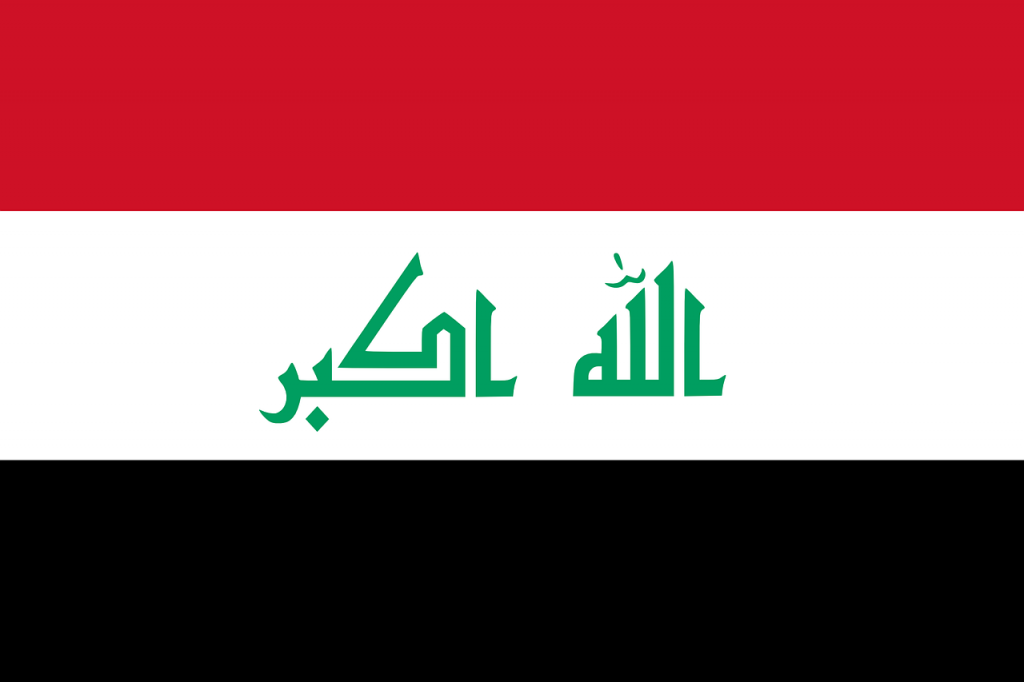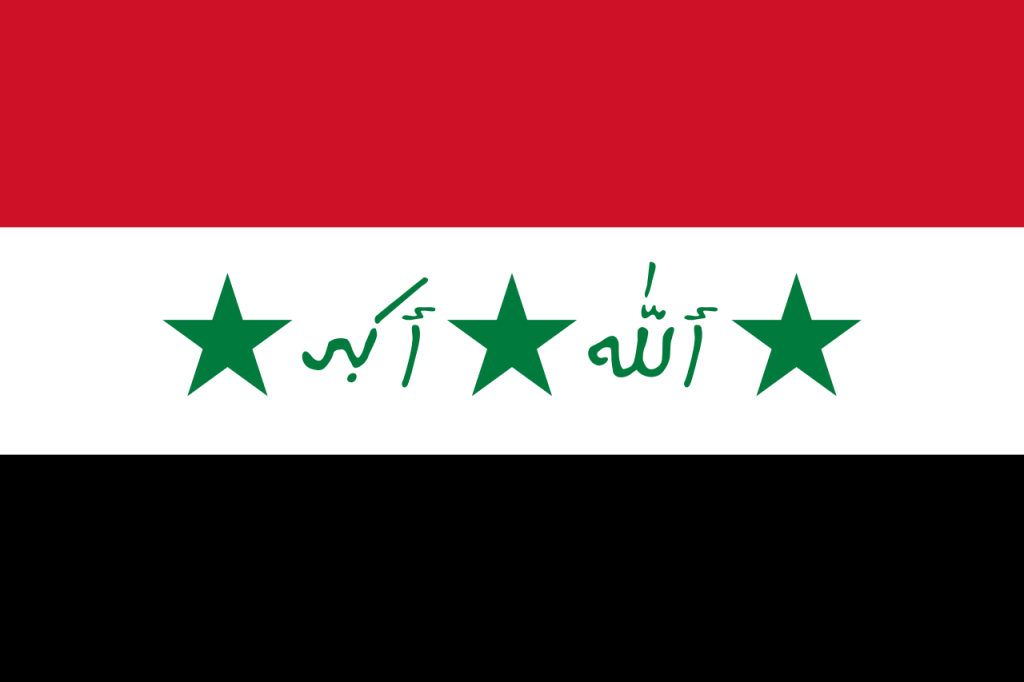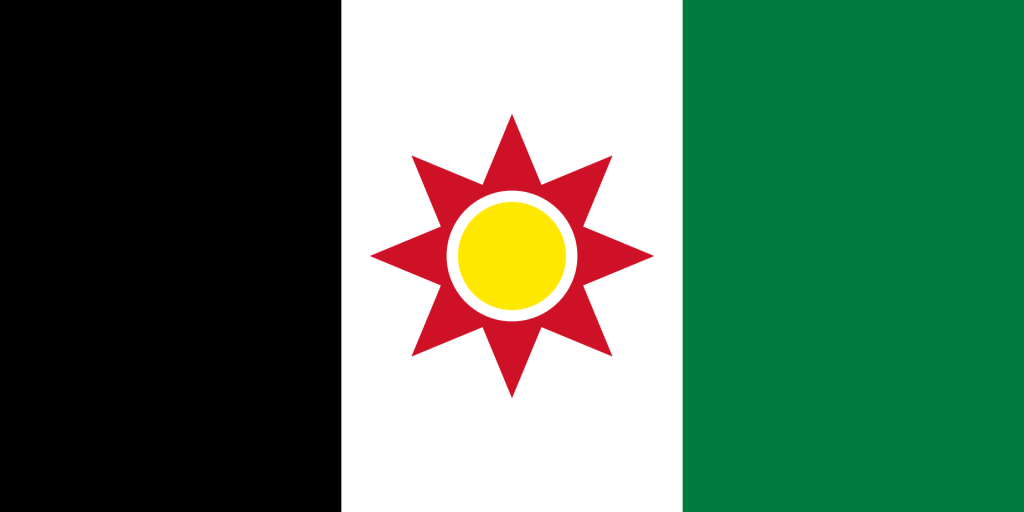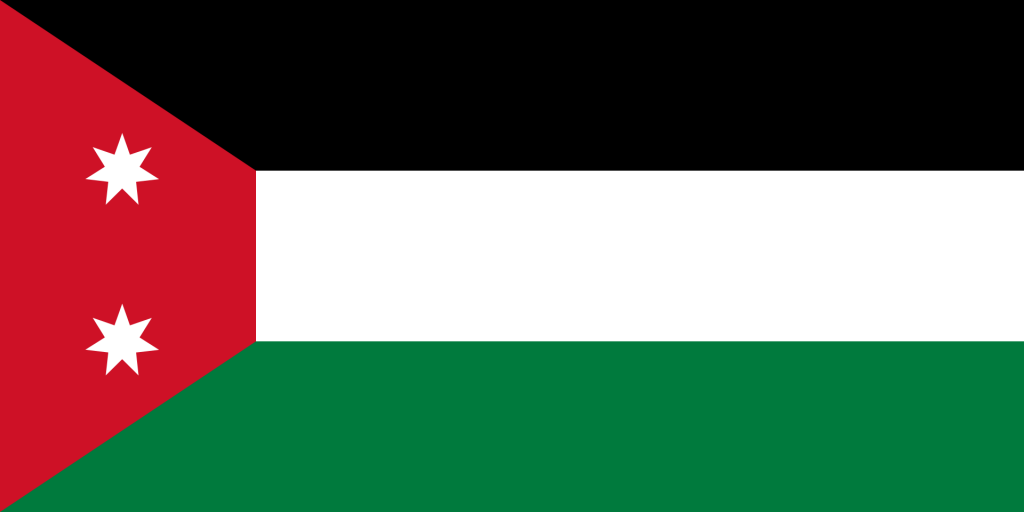The Republic of Iraq has had a long and turbulent history since its modern borders were first established after World War One. In that century of history there have been many flags for many governments, so here we plan to give you the definitive guide to the flag of Iraq! What does it represent, what’s its history and what were some of the old Iraqi flags before the one we have now?
Current Flag of Iraq

So this is the current flag of Iraq. A red, white and black tricolour with some green text in the middle. Let’s start with the most interesting bit, what does the text mean? Well it’s a common Arabic phrase, one of the most common and least understood there is. “God is the Greatest”, most commonly known in its Romanized Arabic “Allahu Akbar”. For a lot of people, this phrase represents a chilling ode of terrorism, but to the average Muslim or even non-Muslim Arab, it’s as natural to express as saying “Thank God” would be to the average westerner.
The term for the phrase is ‘Takbir’ and it’s used in a lot of contexts. Naturally you’d hear it as a call to prayer from Mosques and commonly used in religious events of all kinds, but it’s also just a common expression. A new baby has been born: “Allahu Akbar!” You just witnessed a horrific tragedy: “Allahu Akbar!” Your favourite football team just scored a goal, of course you cry “Allahu Akbar!” in joy. Even Arab Christians say it all the time. After all, Allah isn’t a separate God, it’s just the Arabic name for God.
Now for the colours. You may notice that these are the same colours used by Syria, Yemen, Egypt and Sudan. That’s not an accident. These colours are originally taken from the Egyptian revolution of 1952 and were designed to represent Arab liberation. A number of countries that rallied to that call, particularly in the days of Nasser’s rule of Egypt, decided to adopt it in solidarity with the cause.
The exact meaning of the colours changes depending on the country, but the official explanation for the flag of Iraq is that they allude to a poetic verse by the famed 14th century Iraqi warrior poet Ṣafiddīn al-Ḥilli: “Our actions are bright, our battlefields are dark, our lands are green, and our swords are red with the blood of our enemies”. This also explains the green Takbir.
So there you go, that’s the flag of Iraq summarized. But there’s a whole lot more to this story. How about we take a step back…
Flag of Ba’athist Iraq

This is the flag Iraq had from 1991 to 2004. Very similar, but a few very noticeable differences. What’s with the green stars? And why is the script different? The green stars are notably exactly the same as Syria’s flag, only this time there’s three of them. This leads way back to the attempted United Arab Republic formed between Egypt and Syria in the late 1950s. For a time, those two countries had the same flag with two green stars representing the two states. Iraq decided to go with three stars to signal its intent to one day join the union…
This never came to pass. In the end, the meaning of the stars was changed to represent the three tenets of Iraqi Ba’athism: Unity, freedom and socialism.
Now hold on a moment, what’s Ba’athism? It was the system of government Iraq lived under during the era of Saddam Hussein. And in fact, it’s still the system of government today in Syria! So Syria has the same ideology as Saddam’s Iraq? No, not really! Yes, it is confusing! Ba’athism is one of those annoying ideologies that long ago was formed with a unifying ideal: Arab unity and some vague notion of socialism. This flimsy framework inevitably meant that governments built around it still pursued wildly different policy objectives, which is a big reason why Iraq and Syria never united despite decades of sharing a border and having Ba’athist governments.
But anyway, what about the Takbir? Why’s the script different? The 2004-present version uses a standard Kufic script that’s easily legible. The version from 1991 meanwhile, allegedly, uses Saddam Hussein’s own handwriting. This is even weirder when you consider that Ba’athism is supposed to be a secular ideology and indeed, the flag had been with the three stars but no Takbir all the way since 1963. What had changed in those nearly 30 years? Well, mass devastation in the Iraq-Iran war for one, not to mention ruinous economic sanctons.
The Ba’athist regime was in turmoil and many have suggested that the pivot towards Islam was a way to shore up support from religious conservatives, as well as allegedly to prevent the flag of Iraq being defaced during the incoming invasion of Kuwait.
When Saddam was deposed in 2003, the first step for the new flag of Iraq was taking his handwriting off the damn thing. For a time, the flag of Iraq maintained those three green stars but with the Kufic script as a replacement. But as the stars were so closely aligned with Ba’athism, Iraqi Kurds who suffered mass-murder and genocide under the Saddam regime protested for their removal. It wasn’t until 2008 that the stars were finally removed… To the consternation of many Iraqi Arabs. You can’t please everybody.
Pre-Ba’athist Iraq Flag

Now things are getting interesting, this is totally different! This was the flag of the original Iraqi republic, formed after a military coup in 1958 and hoisting this brand new flag in 1959. The black, white, green and red most prominent in the flag are the colours of pan-Arabism, which you can see in many other flags throughout the region, albeit usually with the red coming in as a triangle from the left side. The choice to do the red as a star is to represent the Star of Ishtar, invoking ancient Mesopotamian history native to the land. And the yellow? The yellow represents the Iraqi Kurds, with a yellow sun being a prominent feature of Iraqi Kurdistan’s flag today.
This flag was not long lived. It came into force in 1959 and was gone in 1963. The leader of the country during this time was prime minister Abd al-Karim Qasim, who took power via military coup. He was an Iraqi nationalist but not a Ba’athist or a pan-Arabist and after a period of increasing unpopularity and surging pan-Arab sentiment, a Ba’athist coup had him murdered and desecrated on TV for all the public to see, then this briefly existing flag of Iraq was consigned to the dustbin of history.
Kingdom of Iraq Flag

Now here’s another flag of Iraq that might look familiar. It’s looking even more like some of the other countries in the region! This is even more directly a take on the pan-Arab flag, though the traditional red triangle has been changed to a trapezoid. And what about those two white stars? You might recognize them from the flag of modern day Jordan. There’s a reason for that. It’s the symbol of the Hashemite dynasty, the ruling royal family in Jordan and at this time, also the royal family in Iraq, briefly Syria and also Hejaz, a now defunct state in the Arabian peninsula. Symbolically, the two stars represent the Tigris and Euphrates rivers.
So this flag of Iraq was in place from 1924 to 1959, the longest lasting flag design in Iraq’s history. It is not, however, a flag many Iraqis pine for as it represented a time when Iraq was at first mostly ruled by the British, with the Hashemite king serving as little more than a puppet, then following independence it was as if they were a client state of Jordan.
Instability rocked this government throughout its lifetime and when the king decided to form a union with Jordan to counter Nasser’s pan-Arab union, the Iraqi military decided it was time to act. A coup was launched, the king, much of the royal family and other officials were assassinated and the rather short-lived republic was proclaimed.
There was another flag before this, but really, it’s just the same as above with the trapezoid extended to a triangle and the two stars removed. This existed from 1921 to 1924 when Iraq was merely a British mandate. It’s a variation of the flag of the Arab revolt, whose influence can be seen across many flags to this day. Countries like Iraq, Syria, Egypt and Yemen instead continue to carry the legacy of Nasser’s pan-Arabism, a dream that’s long gone but still etched into memory on the flag of Iraq, through Ba’athist coup to Saddam dictatorship and today under its present government.
But that’s not the only flag of Iraq, it should be noted! There’s a whole separate flag for Iraqi Kurdistan. Thankfully we have a whole separate article on the flag of Iraqi Kurdistan, which you can feel free to read right here!
Want to join us on a tour to Iraq? Check out our current Iraqi Tour schedule.





